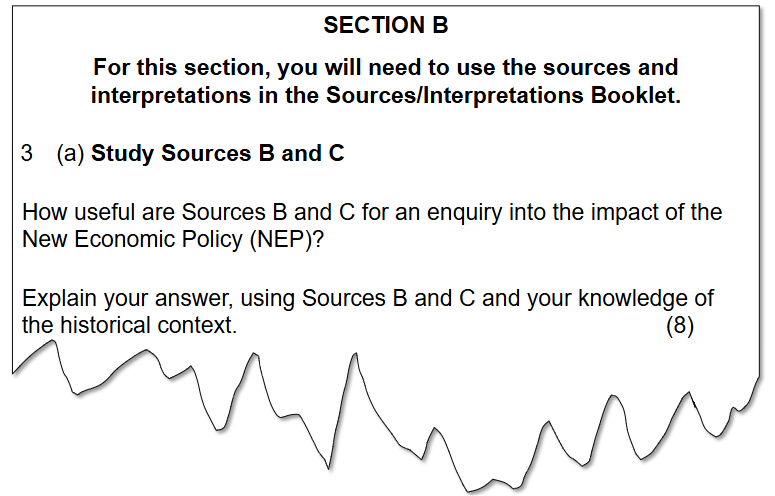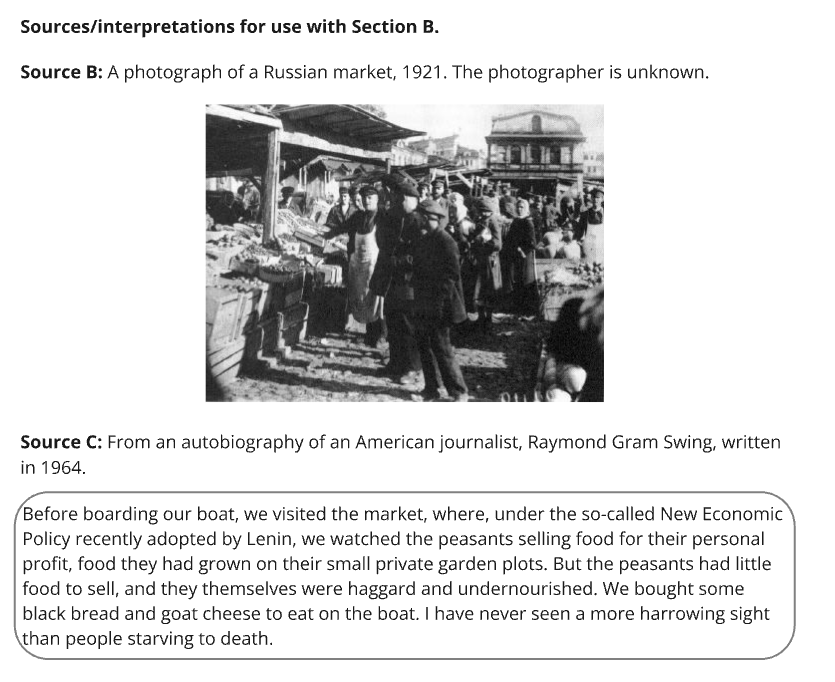The 8 Mark "How Useful are Sources B and C" Question (Edexcel GCSE History): Revision Note
Exam code: 1HI0
Summary of Question 3 (a)
Question 3 (a) requires you to evaluate how useful two sources are for a historian investigating a specific issue
You should:
Refer to the content and provenance of the sources
Use relevant own knowledge to support your points
Make a clear judgement on how useful each source is for the enquiry
This is the first question in Section B of the paper
Questions 3 (a) to 3 (d) will be based on the same topic
Amount of marks | 8 |
|---|---|
The time that you should spend on the question | No more than 15 minutes 5 minutes of planning 10 minutes of writing |
An example of the type of question you may encounter can be seen below:

In previous years, this question has focused on the following topics in Russia and the Soviet Union:
Year of Exam | Question Topic |
|---|---|
2018 | Problems faced by the Provisional Government (opens in a new tab) |
2019 | The achievements of the Five-Year Plans (opens in a new tab) |
2020 | Conditions for workers in towns, 1928–41 (opens in a new tab) |
2021 | Challenges facing the Bolsheviks, 1921–24 (opens in a new tab) |
2022 | Reasons why Stalin won the struggle for power against his rivals (opens in a new tab) |
2023 | The main reason why Stalin’s purges began (opens in a new tab) |
2024 | The experience of women in the Soviet Union under Stalin’s rule |
What is a historical enquiry?
A historical enquiry is when historians ask questions, select evidence and make judgements about the past
All questions in Section B — Questions 3 (a) to 3 (d) — will be focused on the same historical enquiry
The enquiry could be based on either Tsarist Russia or the Soviet Union
If you do not link your answer to the enquiry in the question, you cannot score more than 2 marks
Using the content and provenance of a source
A historical source is made up of:
The provenance
The background of the source
The content
The information the source shows or describes
Provenance
The provenance appears at the top of each source and usually tells you:
Who created it
What type of source it is (e.g. a diary)
When it was produced
Where it was created
For the example question, here is a breakdown of the provenance of Source C:
Who | Raymond Gram Swing |
|---|---|
What | An autobiography |
When | 1964 |
Where | America |
How is provenance important for a "How useful …" question?
Use the provenance to consider:
Is the source typical of what you would expect the author to say or show?
Is the source accurate if it was produced years after the event?
What factors could have influenced their opinion?
Content
Finding the content of a source depends on the type of source you have
Written sources
Read the text closely to understand what it tells you about the issue in the question
Look for:
The author’s overall viewpoint on the enquiry
Key quotes about the enquiry
Visual sources
Look carefully at what the image shows
Ask yourself:
What is happening in the image?
Who or what is included or left out?
What message is being communicated?
Is anything staged or exaggerated?
How is content important for a "How useful…" question?
Use the content to:
Make inferences about the enquiry
Provide evidence for your judgement on the source's usefulness
Making judgements in a “How useful are Sources B and C?” question
The 8 mark "How useful” question requires you to make a judgement
Common mistakes in judgement questions
Saying that neither source is useful
Avoiding a clear decision by using phrases like “kind of” or “maybe”
Focusing on reliability rather than usefulness
All sources are useful for a historian, but not all sources are reliable
A speech by Lenin is likely to contain incorrect information and be biased towards Bolshevik ideals
However, it tells historians about how the Bolsheviks communicated their policies to the public
What makes a good judgement?
Refers to specific content from the source
Uses the provenance clearly
Applies relevant contextual knowledge
Links back to the focus of the question
For the example question, the focus of the question is the impact of the New Economic Policy (NEP)
The limitations of sources
Your judgement does not need to include limitations to get full marks
Students’ responses are often given higher marks if they only focus on the source's strengths
However, if you include a limitation, you must make sure the limitation is:
Supported by knowledge
Focused on the question
Relevant to your answer
"How useful are Sources B and C?" question structure
You will find Sources B and C in the Sources/ Interpretations Booklet
Do not use Source A for this question
This source is only relevant to Section A
It is not included in the insert

Your answer should include:
An explanation of how useful each source is for the enquiry
Use of content and provenance
Specific and accurate own knowledge
Your answer could be written in PEE paragraphs
P — Make a point about the question
Make it clear how useful the source is
Use the source to make an inference about the issue in the question
E — Use information from the source and knowledge to support the point you have made
Your knowledge should be specific
E — Explain why this shows that the source is useful
Focus on the given issue in the question
To get full marks, your judgement must use:
The source's content
The source's provenance
Your own knowledge
You will need two paragraphs
The focus of Paragraph 1 should be Source A
The focus of Paragraph 2 should be Source B
You will achieve 8 marks for your analysis and evaluation of how useful both sources are for the enquiry (S)
Worked example of a "How useful are Sources B and C?" question
Worked Example
3 (a) Study Sources B and C.
How useful are Sources B and C for an enquiry into the impact of the New Economic Policy (NEP)?
Explain your answer, using Sources B and C and your knowledge of the historical context.
(8)

Answer:
Source B is useful for an enquiry into German recovery in the years 1924-29 because it shows the success of limited capitalism in Russia (S). The photograph shows stalls and traders selling produce in a busy market, which suggests that people were once again allowed to buy and sell goods for profit (S). From my own knowledge, I know that the NEP, introduced in 1921, allowed peasants to sell surplus food and replaced grain requisitioning with a tax-in-kind. This marked a shift away from War Communism and helped revive the economy in urban areas (S). The source is useful because, as a photograph from 1921, it gives visual evidence that the NEP immediately had an effect on everyday life as soon as it was announced. However, as we do not know the photographer, this scene could have been staged by the Bolshevik government for propaganda (S).
Source C is also useful for this enquiry because it shows that not all people were positively impacted by the NEP (S). The journalist describes peasants as "haggard and undernourished” and speaks of “people starving to death,” which suggests that the NEP had not solved the problems caused by the Civil War and War Communism (S). From my own knowledge, I know that the NEP helped to stabilise the economy in cities, but rural areas, especially those hit by famine, continued to suffer. Many peasants still struggled to produce enough food or make a profit (S). The source is useful because it is a first-hand account written by someone who visited Russia during the NEP, even if the book was published later. It shows that although there were visible changes in policy, the overall standard of living remained poor for many Russians (S).

Unlock more, it's free!
Did this page help you?